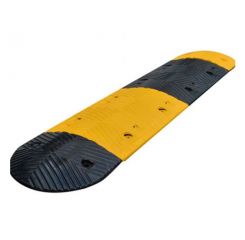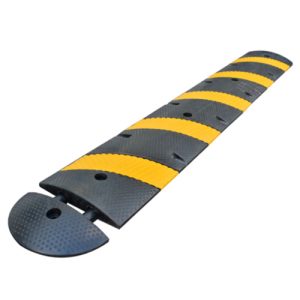In an increasingly motorized world, the coexistence of pedestrians and vehicles in urban areas can be a challenging affair. The need for safe driving in pedestrian zones has never been more pronounced. Among various methods used to ensure road safety, speed bumps and speed humps play a significant role in managing vehicle speed. Both these traffic control devices have distinct applications and are employed based on the specific needs of a location. This article explores the efficacy of speed bumps and speed humps in promoting safe driving and their applicability in different scenarios.



Premium Reclycled Rubber Safety-Striped Speed Hump – Reflective Rubber

Heavy Duty Rubber Speed Hump – Yellow / Black – Low Profile Speed Bump
Speed Bumps
Speed bumps are vertical obstructions in the road, typically around 3 to 6 inches high and 1 to 3 feet wide. They act as aggressive slowing measures, forcing drivers to reduce their speed to around 5 to 10 mph. Speed bumps are particularly useful in areas where pedestrians and traffic share space more equally, such as near schools, parks, and shopping areas.Speed Humps
Speed humps, on the other hand, are more gentle in design. These are longer, usually 12 to 14 feet in width, and not as high as speed bumps. They can be crossed at a speed of 15 to 20 mph, making them suitable for places where traffic needs to flow without hindering pedestrian safety.Where to Use Speed Bumps and Speed Humps?
Speed Bumps in Shared Spaces
In small areas where pedestrians and vehicles share the space equally, speed bumps are more appropriate. The following are typical scenarios:- Parking Lots: To prevent accidents and ensure pedestrian safety, speed bumps are used to enforce very low speeds.
- School Zones: Children’s safety is paramount, and speed bumps are effective in forcing drivers to proceed with caution.
- Shopping Districts: Busy commercial areas with bustling pedestrian activity can benefit from the installation of speed bumps to maintain low speeds.
Speed Humps for Continuous Flow
In contrast, speed humps are useful in areas where slowing traffic is necessary, but the flow must continue. Here are some applications:- Residential Streets: To protect pedestrians without hindering daily commutes, speed humps are often installed in residential areas.
- Hospitals and Care Facilities: Speed humps maintain a safe speed for ambulances and other vehicles without causing unnecessary delays.
- Near Parks and Recreation Areas: To ensure safety near parks without impacting traffic, speed humps provide a smoother slowing mechanism.
Pros and Cons: Analyzing Effectiveness
Advantages
- Controlled Speeds: Both speed bumps and speed humps are effective in controlling vehicle speeds, significantly reducing the risk of accidents.
- Enhanced Pedestrian Safety: They help protect vulnerable road users, such as children, the elderly, and people with disabilities.
- Customized Applications: By selecting the appropriate device, communities can balance safety and traffic flow according to their specific needs.
Disadvantages
- Potential Vehicle Damage: Especially with speed bumps, if not traversed with care, there can be damage to the vehicle’s suspension and alignment.
- Emergency Vehicle Access: Speed bumps, in particular, can delay emergency vehicles, and careful planning is needed to prevent hindrance.
- Weather-Related Issues: Snow and ice can render both speed bumps and speed humps hazardous or ineffective if not maintained properly.



